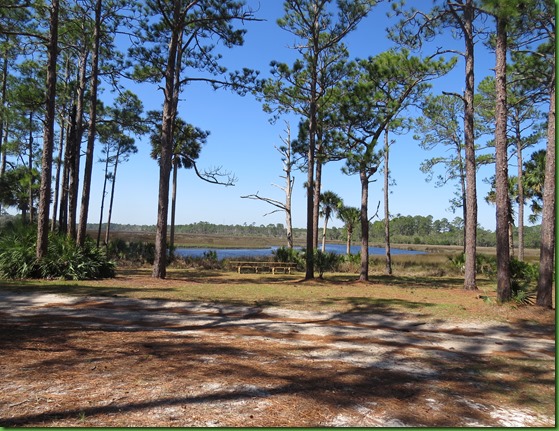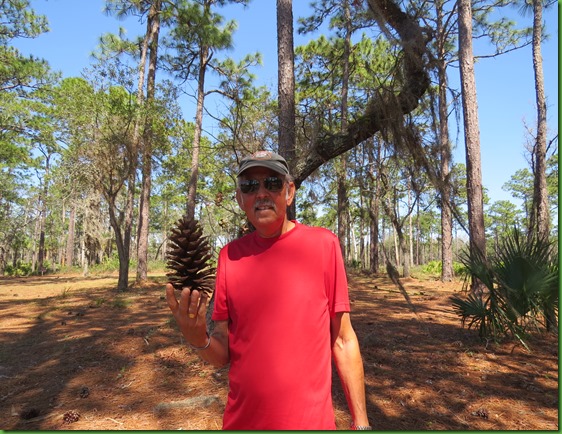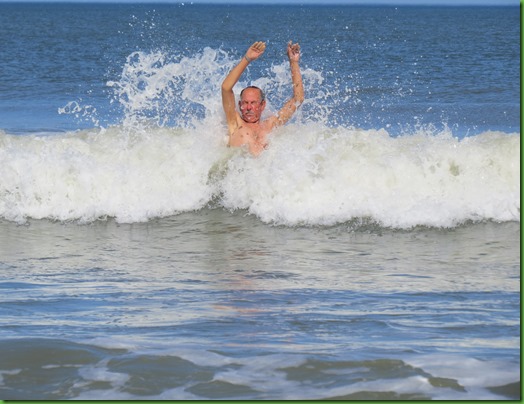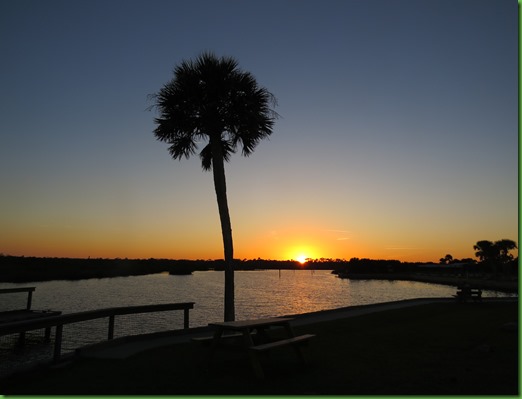Tuesday March 15, 2016 Most Recent Posts:
Gamble Rogers State Recreation Area Postcards From the Beach
Flagler Beach, Florida Magnificent Skies and the Beautiful Washington Oaks Gardens
The birds making the most noise around our rig are these boat tailed grackles. They are noisy, at sunrise and pretty much all day long and sometimes after dark. Now don’t get me wrong, it beats motorcycles but you’d think they could take a bit of a break.
Another cloudy sunrise where the skies are orange and the sun white hot. No matter what the skies are doing the sunrise is beautiful.
On my walk this morning I see, among other things some bird bathing and interesting sand patterns
This guy dips and shakes as the waves roll in and out. He seems unconcerned with them. Fun to watch.
This photograph doesn’t do the lovely water patterns in the sand justice. Nature’s art, beautiful!
The snowy egret too is walking in and out of the waves fishing and doing pretty well this morning.
After breakfast, we drive up to Faver-Dykes, another fairly close by state park. There really are many state parks within 20 miles or so. We’ve been to North Penninsula, Bulow Creek, Bulow Plantation Ruins and Washington Oaks Gardens already.
Faver-Dykes has a lovely long entrance road. This is the sort of road I remember all roads being on my first visit to Florida as a child. Things have changed dramatically here in my life time.
First thing we check out is the boat dock which looks great and takes you right out into Pellicer Creek. A definite must do for me.
Pellicer Creek eventually enters the magnificent lagoon at the Matanzas River where it meets the Atlantic Ocean. Pretty sure that means it would have to go right past Washington Oaks as part of the Matanzas and enter the Atlantic somewhere in the vacinity of the coquina beach there.
Next thing is to check out the campground where we find 33 sites on an oval sandy road. The campground is located in a lovely hardwood hammock with natural vegetation buffers between sites.
Each site has water, electricity, a picnic table, grill and fire ring. There is a dump station.
Before we came, I looked up the sites here to see which numbers they claimed Winnona would fit into at 35’. There were about 10 and Reserve America had them all listed as being 40’ long and 18’ wide. The sites that I see are not that size. Not sure any of them is 40’ by 18’. Some but not all are that long and many are wider.
Be careful if you have slides when using Reserve America’s length and width information. Whoever provides it from the park may not be providing site specific information. After seeing the sites, we cut the list of those that would work in half. But we could definitely come and stay for a while in this quiet spot.
The information provided by the park on their facilities lists three hiking trails but we find only two. The trail head for the hardwood hammock hike is in the campground so we park the car and set out.
It’s clear we are in a new habitat when we see the pignut hickory trees towering above us with their bare leaves. This one has a mistletoe ball in the top.
The bark of the pignut has interesting patterns. More of nature’s artwork.
I have a hard time finding nuts on the ground. The squirrels or whoever have cleaned most of them up.
The trail eventually leads us through an ecotone to a salt marsh which although it looks like a grassy field would not be so great to walk through since it either has standing water or mud you would sink into.
At one point there is a nice bench where you could sit for a while and just be in this place. We might well have done that had someone else not already beaten us to it. These are the only people we see on the trail.
Next we check out the picnic area which also has a view of the river and the second trail head. Again we are in another habitat. The area is covered with long brown pine needles with some big pine cones. This is the longleaf pine forest. The trail starts off as a sandy road leading into the pine forest and becomes a trail just ahead and to the left in this picture.
In the 1500’s, before Europeans arrived longleaf pine forests covered nearly 90,000,000 acres from Eastern Texas to Florida and north to southeastern Virginia. It dominated the southern landscape. Its range was defined by the frequent, widespread, natural fires that occurred throughout the southeast. Unlike today, other southern pine species such as loblolly and slash pine were mostly relegated to areas where fire did not burn frequently such as the edges of streams and ponds. .
In the late 19th century, these virgin timber stands were clear cut to less than 5% of its original range.: That’s pretty near extinction.
Their come back was made nearly impossible by our policy of suppressing forest fires. Thankfully we have moved to controlled burning which is necessary for this habitat to thrive.
And thrive is what we want. In John Muir’s 1000 Mile Walk to the Gulf, which is a wonderful read and a fascinating description of walking the southeast in 1867-68 just after the Civil War, he describes a day spent walking through this habitat.
'In "pine barrens" most of the day. Low, level, sandy tracts; the pines wide apart; the sunny spaces between full of beautiful abounding grasses, Liatris, long, wand-like Solidago, saw palmettos, etc., covering the ground in garden style. Here I sauntered in delightful freedom, meeting none of the cat-clawed vines, or shrubs, of the alluvial bottoms.'

These are TALL trees, 80 to 100 feet tall.
Longleaf pine is also the longest lived of the southern pine species. They take 100 to 150 years to reach full size. Throughout most of its range, individual longleaf pines can reach 250 years in age. Some have been documented to live in excess of 450 years old. The bark is thick, reddish brown and is scaly like other pines.
I think they should be called long needle pines personally. I know the needles are technically leaves but that isn’t what we think of when we say the word leaf. Anyway, these needles are seriously long. In fact they are the longest needles of all southern pines, ranging in length from 7 to 18 inches. The needles are grouped in threes and arranged in tufts on the end of branches. Becasue they are high in natural volatile chemicals, longleaf pine needles are slow to decay once they fall to the forest floor. In the past frequent fires throughout the woods easily ignited the dead needles and cleaned the forest floor of pine needles and other debris.
The needles were frequently used by Native Americans and early settlers to weave into baskets.
The pine forest also borders the creek.
The trail takes us out of the pines, through the palmettos and back into the pines.
The pine forest also borders the salt marsh. I love the colors and shapes of the bark on the longleaf pine.
David shows the size of the cones which can be up to a foot long.
I wonder how many of these baby cones would actually have grown up to full size had the bundles of needles not come down off the tree?
The turkey oak is part of the understory in the Longleaf pine forest. Its name comes from the shape of its leaves which supposedly look like a turkey foot. Not sure, what do you think?
Also in the understory are thistle, beloved of the birds. Not sure this white one will turn all pink/purple but maybe. I love its purple tinge at this point.
I think Faver-Dykes is an ideal park if you want to get away from the crowds and have a rig no bigger than 35’. It was a wonderful way to spend our morning. We head back for lunch and an afternoon on the beach.
The weather is warm enough and the waves are big enough to play in again today.
Not sure why we have the beach mostly to ourselves.
Someone else has been here having some fun though. How about this sand “sculpture”! We find it just behind where we are sitting.
So far, he doesn’t look sunburned. Not even on his bald head.
Another sunset, same place almost the same time. I sure do love being able to see the sun rise and the sun set every single day.






































Great place! You sure do know how to spend time at the beach:)
ReplyDeleteFantastic pictures of nature. I was taking Thistle pics yesterday myself.
ReplyDeleteThose sunrises are beautiful! Fayver-Dykes looks like a very nice park. Had never heard of it before.
ReplyDeleteThat sand sculpture is hilarious! Looks like you're enjoying some wonderful beach days. We've been considering Fayver-Dykes for next winter -- thanks for the great preview. It's even prettier than I imagined -- reminds me a bit of the Ochlockonee, which we love.
ReplyDeleteI second Laurel's comment, the place reminds me of Ochlockonee SP too, one of my fave state park in Florida. You are so lucky you can see the beginning and the end of the day, perfect spot!
ReplyDeleteLooks like a wonderful place to hang out, and we are less than 35 feet too! By the way, your email notification had a non working link. I came to blogger reading list and found you here, so all is good.
ReplyDeleteIt's amazing how fire impacts the ecosystem. And to think man knows better than Mother Nature and suppresses fire. You shared a lovely walk in the woods and taught me all about long leaf pines. You are quite the teacher! :c)
ReplyDeleteThank goodness we finally learned about fire and forest health. Those 'longleaf' remind me of Ponderosa Pine. Does the bark smell like vanilla like the Ponderosa does? I still have a purse my Grandmother wove from those 'needles'. Love the sand sculpture but I think its feet are on backwards.
ReplyDeleteThe southern pines are quite eye catching. We do have grackles up here, and they can be noisy.
ReplyDeleteLovely Florida photos:) Those are some major pine cones for Florida! What a clever sand sculpture...glad he isn't getting sunburned:)
ReplyDeleteThose particular leaves do not look so much like a turkey foot as some we saw later. Good question about how many of those baby cones might make it to maturity. So many conditions must be met for even one seed to grow, it is a wonder any survive, but they do. Thanks for capturing the splendid spectacle they present when there is widespread success in one area.
ReplyDeleteYour pictures are wonderful, And I love the sand sculptor
ReplyDeleteUgh, Grackels are the worst! We had them in PA constantly eating all the bird seed we would put out for the Cardinals :) David looks like he's enjoying the ocean surf!
ReplyDeleteMy favorite photo is the first - that grackle looks like such a bossy character, and I had to laugh.
ReplyDeleteThe birds flying across the golden sky is incredible. When we make our way to the east coast I will have to be up early! Thanks for all the great information on the beautiful pines. Love the long needles, they look so graceful. The sandman is so clever! Wonder if they had a model, or just good memories :-) It's so dry here, I love spending time at the water with you.
ReplyDeleteLovely hike and afternoon at the beach nearly to yourselves...how devine. Florida is really amazing for having so many habitats in one state! We have a blue jay here who will not let up in the early mornings. Sorry grackle-you don't win the beauty prize, but, nonetheless, a very good picture of his majesty. Beautiful sand art...interesting sand sculpture...ah, what you can see at the beach!!
ReplyDeleteTHanks for the tree lesson, I really enjoyed learning about the pines.
ReplyDelete